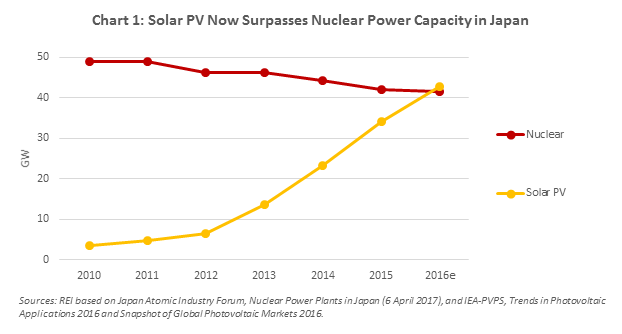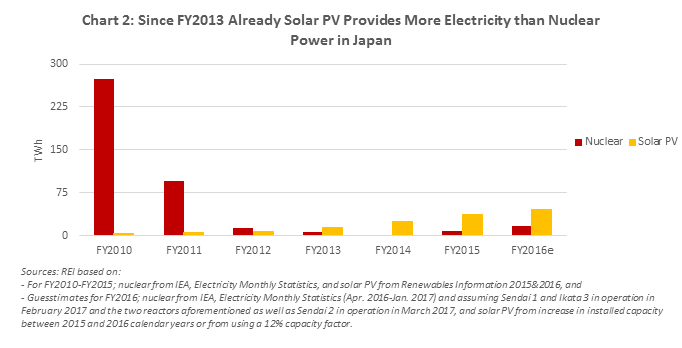Solar now provides more installed power, and more electricity than nuclear in Japan in Japanese
Tomas Kåberger, Chair of Executive Board, Renewable Energy Institute
Following the introduction of a feed-in tariffs (FIT) in July 2012, solar photovoltaic (PV) scaled up fast in Japan. As a result of this growth the technology has recently passed a milestone: Solar PV has passed nuclear electricity in Japan.
In 2016, with about 43 gigawatts solar PV capacity, solar power exceeds the capacity of all the officially operational nuclear reactors (chart 1). This has been made possible thanks to on the one hand the FIT scheme mentioned in introduction, which with generous tariffs enabled remarkable growth, on the other hand the decommissiong of Fukushima Daiichi’s six nuclear reactors and of six other small ageing reactors.

Already since FY2013 solar electricity contributes more to Japan’s electricity supply than nuclear reactors (chart 2).

The relationship between installed capacity in GW and the resulting annual electricity delivered, measured in GWh is usually very different for solar and nuclear.
Nuclear power plants are supposed to produce at full power day and night for most of the year. Only shutting down a few hundred hours for changing fuel, checking equipment and doing preventive maintenance. So, multiplying the power capacity in GW with expected, say 8 000, full load operating hours will give you the annual electricity generation in GWh.
But as most of the reactors officially reported as operational are not operating, the average hours was as low as around 400 full load hours in Japan last fiscal year.
Solar PV in Japan, on the other hand, produces electricity only when the sun shines, only half of the hours, and often below maximun power, yielding only around 1 000 full load hours per year. This is about the same solar capacity factor as in Germany and Scandinavian countries, but only half of the capacity factor in the sunniest places in deserts of the Middle East or America.
At present, the value of solar electricity is higher than the value of nuclear electricity. The reason is that solar power is produced during day time when demand is higher than during the night. In Japan the value of solar electricity is also higher as production is more intense during the hot summer period when seasonal demand is at its highest, and the most expensive power plants would otherwise be needed.
When solar becomes the dominating source of power this will no longer be true. Then the solar generation will substitute all but the very cheapest power plants in the middle of the day, while more expensive plants will operate during the dark nighttime. Only a few places in the world has so much solar power that this is the case.
Keeping nuclear reactors operational without operating them is expensive. The cost and difficulties of investing in safety upgrades. putting them in shape to operate again and training the personell will make it expensive to restart them.
It will be technically difficult to restart many of them because they have been shut for long.
As a result it is likely that solar will not only increase the lead in installed capacity, but also in the future provide more electricity than nuclear reactors in Japan.
Then, the Basic Energy Plan will need to be revised.

